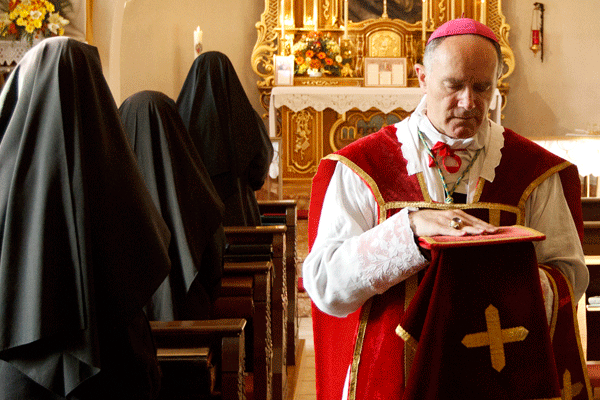
VATICAN CITY (CNS) — The documents of the Second Vatican Council possess different levels of authority and thus command different levels of acceptance by Catholics, including those who hope to restore their unity with the church, said two retired Vatican officials.
German Cardinal Walter Brandmuller and Italian Archbishop Agostino Marchetto spoke to reporters May 21 after presenting a book they wrote with Father Nicola Bux, “Pope Benedict XVI’s Keys for Interpreting Vatican II.”
The three scholars have written extensively on how the Second Vatican Council must be read in continuity with earlier church teaching and have often criticized theologians, priests and other Catholics for reading too much novelty into the council.
At the book presentation, Cardinal Brandmuller and Archbishop Marchetto responded to reporters’ questions about the Vatican’s ongoing discussions with the traditionalist Society of St. Pius X, which has a history of criticizing the Second Vatican Council and rejecting some of its teachings.
In the book, Cardinal Brandmuller said the SSPX and the Old Catholics who rejected the papal infallibility teaching of the First Vatican Council “have in common a rejection of the legitimate developments of the doctrine and life of the church.”
While the cardinal described the Old Catholics as having an “insignificant role” in global Christianity today, he said the vitality of the SSPX forces the church “to demonstrate that their protests are unjustified. One can only hope this will happen.”
Asked about the passage in the book, Cardinal Brandmuller told reporters, “We hope that the Holy Father’s attempt to reunify the church succeeds.”
One thing that must be kept in mind is the differing degree of acceptance and obedience Catholics owe to different types of church teaching, which range from absolutely embracing the teaching in the creed to accepting the principles of Catholic social teaching and trying to put them into practice in a variety of social and political situations, said the cardinal, who is the former president of the Pontifical Committee for Historical Sciences.
“There is a huge difference between a great constitution,” like the Vatican II constitutions on the church, the liturgy and divine revelation, “and simple declarations,” like the Vatican II declarations on Christian education and the mass media.
“Strangely enough, the two most controversial documents” for the SSPX — those on religious freedom and on relations with non-Christians — “do not have a binding doctrinal content, so one can dialogue about them,” the cardinal said.
“So I don’t understand why our friends in the Society of St. Pius X concentrate almost exclusively on these two texts. And I’m sorry that they do so, because these are the two that are most easy to accept if we consider their canonical nature” as non-binding, he said.
Of course, the cardinal said, all the council’s documents, including the two declarations, “must be taken seriously as expressions of the living magisterium,” the official teaching of the church, which has developed even further under the pontificates of Popes John Paul II and Benedict XVI.
Archbishop Marchetto, who retired in 2010 as secretary of the Pontifical Council for Migrants and Travelers so that he could dedicate himself full time to studying and writing about Vatican II, said all Catholics owe all the council documents “at least an adhesion of intellect and will.”
The archbishop is not part of the Vatican’s dialogue with the SSPX, but, he said, “from what I have learned, there must be an acceptance of the council by those who want to be reunited with the church.”
“I don’t think the SSPX can say, ‘Well, we’ll set this or that document aside,'” Archbishop Marchetto said.
— By Cindy Wooden, Catholic News Service





